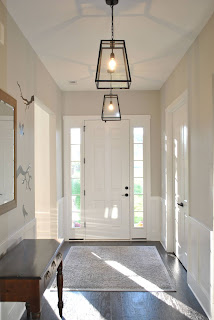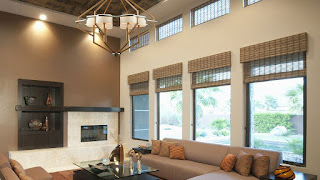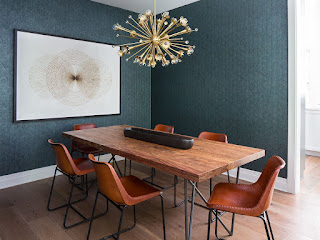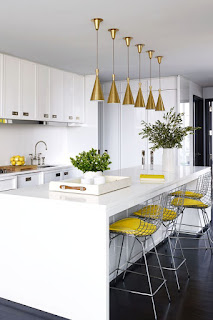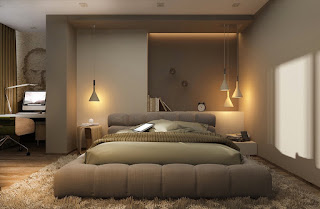How can you change the light in your home for a happier and more productive you? Fortunately, there is a lot of scientific research on the effects of light that can help with your interior lighting design. Instead of remodeling your home, you may just a need a slight tweaking of your lighting scheme.
Lighting is one element of interior design that is often overlooked. But, when you consider it, the lack of proper lighting can have a tremendous impact on your space. Lighting can affect your mood and even the overall perceived size of a space, which is why it is an essential element to any design scheme. Proper lighting can drastically alter the atmosphere of your room, it can enhance the colors used in your decor, and it can even prove useful in marking different areas of your home. Essentially, there are three types of lighting designers use to create style and functionality – general lighting, task lighting, and accent lighting.
Simply put, general lighting makes a room visible, illuminating the bulk of the area. Task lighting is the type of lighting used to facilitate close-range work, such as reading, working on hobbies or crafts, or food preparation. And finally, accent lighting is used to change the mood and atmosphere of your space. This lighting is used to create ambience and drama by delivering light to a focal point in the room, and overall it is one of the hardest types of lighting to properly create. That’s where we come in. This article is full of design tips that will help you learn how to correctly light the rooms in your home.
In order to properly light your space, you must first envision all the possible situations you will use that particular room for, and how lighting will be needed. Imagine yourself in each scenario and think about where your light will be coming from. For example, in the living room, try to envision the functionality of that space and at different times during the day. Will your guests retire to your living room after you’ve hosted a dinner? Will this be your family’s Game Night destination? Will you spend time curled up reading in your favorite living room chair? All of these different scenarios require specific types of lighting. Once you have determined how you would like to use your space, you can move on to selecting what type of lighting and light fixtures you will need.
Lighting Design Factors:
Size and space
Occupant’s age and preference
Ceiling height and shape
Color of walls and furniture
Existing lights and electrical setups
Points of interest, art work, and highlight areas
Traffic patterns
Shadows and reflections
Daylight integrations
Surface characteristics
Color appearance
Lighting controls and distribution
Source, task, and eye geometry
Economics and energy efficiency
Spatial perceptions
Level of illumination (lux)
Psychological and physiological factors
Electrical codes, documentation, and specifications
Although we can give you some general guidelines for how to light the different rooms in your home, every home is different and requires specialized attention. Take this guide as a starting point, but remember that you will probably need to consult with a professional in order to get your space exactly how you want it.
Remember, that color is also a huge contributor to your psychological and physiological states. The color of your rooms combined with the color temperature of your lighting can mean the difference between feeling sluggish and depressed or lively and optimistic.
INTERIOR DESIGN GUIDE TO PROPERLY LIGHTING EACH ROOM IN YOUR HOME
Proper lighting can create a warm and welcoming environment in your home.
FOYERS AND ENTRYWAYS
This is the point of entry into your home, so be sure to make a good first impression. The lighting in your foyer should create a warm, welcoming effect. Hanging pendants, chandeliers, and wall sconces will work nicely here.
LIVING ROOMS
The majority of our time is spent here, so it is important to have easily controllable (think dimmers) and functional lighting in this space. Try to combine overhead lighting with a mix of floor and table lamps. Don’t forget to make use of the natural light in your living room as well. Open shades and draperies to let daylight filter in. Not only does it make your home look beautiful, but it saves energy too.
DINING ROOMS
Your dining room is a place for relaxation – a place where you will share many family meals and host dinner parties, so lighting is extremely important in this space. Strategically placed pendant lights or chandeliers above the dining room table are a must. And of course, don’t forget to install dimmers to your dining room lighting. It is a fantastic way to add drama and ambience.
KITCHEN
All the lighting in your kitchen should be utilitarian and task-focused, pointing downward toward your work surfaces. A good ceiling light is also necessary in the kitchen (for example, recessed lighting). The kitchen is also a great place to combine aesthetics with functionality. The use of under-cabinet lighting can greatly define the character of that space, all while adding functionality.
BEDROOMS
Soft, ambient lighting is best to use in bedrooms to help you relax and unwind at the end of the day. Bedside lamps and wall lights with dimmers are perfect in this space.
Once you’ve mastered what type of lighting you need for each room, try playing with different layers of light to accentuate the architectural features in your space. Remember, the right lighting can have a dramatic affect on a room. Lighting can have the power to change a space from plain and uninviting, to warm and welcoming. So, be sure to select lighting that will not only suit the style and function of your space, but will also enhance the ambience of your home.
Lighting and interior design go hand in hand when creating your perfect space. Contact us for more home design tips or to schedule your appointment with one of our award-winning interior designers.

